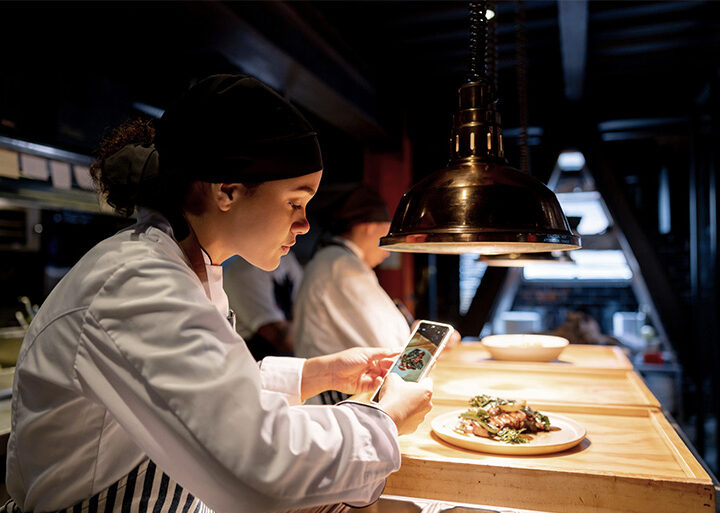In the past, opening a restaurant meant investing in real estate, interiors, and foot traffic. But in 2025, the game has changed. Welcome to the era of Cloud Kitchens — a smarter, leaner, and more scalable way to run a food business.
If you’re planning to start a food brand this year and wondering whether to go for a dine-in setup or a delivery-only model, this guide is for you.
What is a Cloud Kitchen?
A Cloud Kitchen, also known as a ghost kitchen, dark kitchen, or virtual kitchen, is a commercial kitchen space that produces food exclusively for delivery. There is no dine-in facility, no customer walk-ins, and no need for prime real estate.
Food is prepared, packed, and delivered through online food aggregators like Zomato, Swiggy, or your own delivery app.
Think of it as an online-only restaurant where the product is food and the storefront is digital.
Why is the Cloud Kitchen Model Booming in 2025?
In 2025, several factors are driving the growth of cloud kitchens:
- Low setup cost compared to traditional restaurants
- Massive growth in online food ordering
- Flexibility to launch multiple brands from one kitchen
- Data-driven decisions using delivery platforms
- Scalability without real estate expansion
This model has made it possible for chefs, food entrepreneurs, and even home cooks to turn their culinary skills into a profitable business — without huge capital.
How Does a Cloud Kitchen Work?
Here’s the basic flow:
- You set up a kitchen (home-based, rented, or shared).
- You list your food brand on delivery platforms like Zomato and Swiggy.
- Customers order online.
- Food is prepared, packed, and handed to the delivery partner.
- You receive payments post-delivery, minus commissions and taxes.
In short, your customer acquisition, ordering system, and delivery logistics are managed digitally.
Cloud Kitchen Business Models
There are multiple ways to run a cloud kitchen:
1. Single Brand, Single Kitchen
You run one brand from one kitchen. Ideal for beginners.
2. Multi-Brand Cloud Kitchen
You run 2–5 different cuisine brands from the same kitchen. For example, one brand for biryani, one for Chinese, one for desserts.
3. Aggregator Kitchen (Shared Space)
You rent a slot in a kitchen facility with other brands. Useful if you don’t want to invest in your own kitchen setup.
4. Franchise Cloud Kitchen
You buy into an existing cloud kitchen brand and operate under their system.
Cost to Start a Cloud Kitchen in 2025 (India)
| Item | Approximate Cost (INR) |
|---|---|
| Kitchen Equipment | ₹1,00,000 – ₹3,00,000 |
| Rental Kitchen Space (monthly) | ₹25,000 – ₹80,000 |
| Licenses (FSSAI, GST, Fire) | ₹10,000 – ₹20,000 |
| Packaging & Branding | ₹15,000 – ₹30,000 |
| Staff (2–3 people) | ₹30,000 – ₹50,000 |
| Digital Marketing & Setup | ₹20,000 – ₹50,000 |
Total Initial Setup Estimate: ₹2.5–5 Lakhs (Basic Model)
Benefits of Cloud Kitchen in 2025
- Lower Operational Cost
No rent for expensive locations or large teams. - Faster Break-Even
Most cloud kitchens see ROI within 12–18 months. - Scalable
You can easily add more brands or locations once you’re stable. - Data-Driven Marketing
Platforms like Zomato give real-time feedback on pricing, reviews, and sales. - Customer Reach
You can reach thousands of customers in your delivery zone without a single hoarding.
Challenges in the Cloud Kitchen Model
While it sounds attractive, there are hurdles you must be aware of:
- Heavy aggregator commissions (25–35%)
- High competition in categories like biryani, rolls, and Chinese
- Dependency on digital reviews
- Difficult to build brand loyalty
- Margins can shrink if menu isn’t optimized
This is why you need both consulting and marketing support to ensure your brand is ready before you scale.
Who Should Start a Cloud Kitchen?
- Aspiring food entrepreneurs with limited capital
- Home chefs looking to go commercial
- Restaurateurs wanting to test new concepts
- Franchisors looking to expand to new zones
- Food brands focused on Gen Z and millennial audience
How to Make Your Cloud Kitchen Succeed?
At Restromark, we’ve worked with over 200+ food brands and here’s our top advice:
- Do consulting first: Menu engineering, costing, and delivery radius analysis.
- Keep your menu tight: Start with 5–8 dishes that are high margin and scalable.
- Use smart packaging: Food should look and travel well.
- Invest in branding: Even if it’s delivery-only, your name, logo, and packaging must feel premium.
- Run targeted ads: Promote your brand in a 3–5 km radius using Zomato/Swiggy growth ads and Instagram.
Want help setting up your cloud kitchen the right way?
👉 Read our complete guide on Restaurant Consulting vs Marketing
Final Thoughts
A cloud kitchen is not just a trend — it’s the future of the food industry in India.
But success doesn’t depend only on the idea. It depends on the execution.
Before you spend on marketing or build multiple brands, ask yourself:
- Is my menu engineered for profit?
- Is my kitchen optimized for delivery?
- Do I understand customer behavior in my locality?
Start small, plan smart, and scale fast.
And when you’re ready to build a brand (not just a business), Restromark is here to help.





